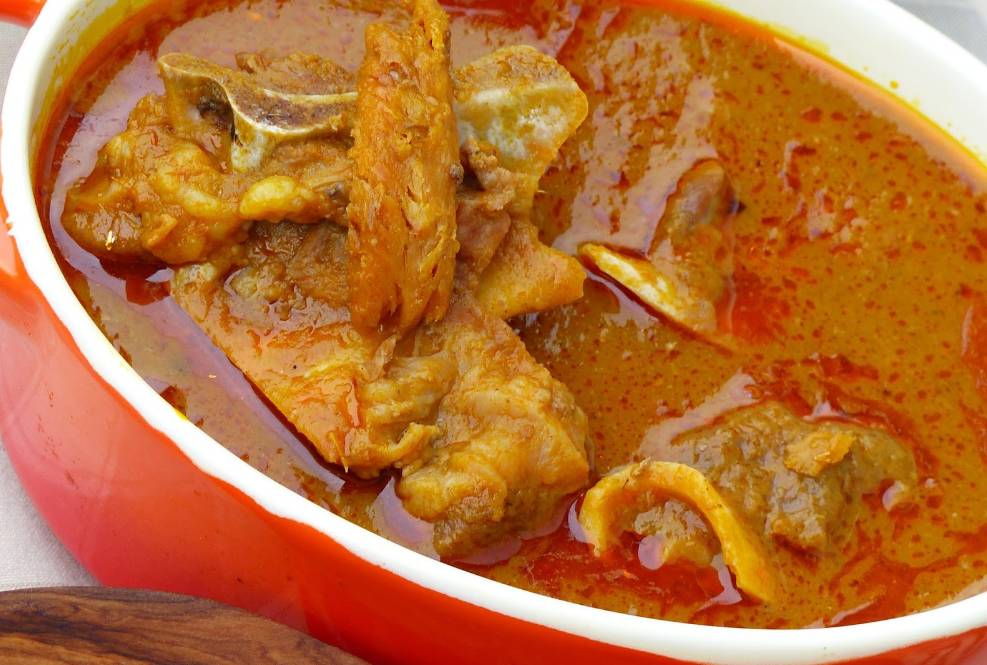Abenkwan, or palm nut soup, is a delicacy commonly known in Ghana and made from the nuts of a palm. The name was derived from the Twi language, with Abe meaning palm and nkwan meaning soup. Besides being delicious, the soup, which is prepared with several ingredients, contains a lot of nutrients that are good for the body. Not only that, it also has many ways of consuming it, so economically, it’s great for people who want to save time from having to prepare different soups for different food types. However, preparing a palm nut soup necessitates some effort due to the need for pounding, and it takes time to cook thoroughly.
Initializing the preparation
It is very important to be aware that preparing abenkwan or palm nut soup requires a bit of time and effort before starting it so that you don’t just give up in the middle of it. First, let’s look at the utensils you will need before moving on to the ingredients and the preparation process.
Utensils
As you know, you have to get your pot, source of heat, and other cooking utensils ready to make the soup. Having the following utensils readily available will prevent you from frantically searching your apartment when the food is on fire.
1. Palmnut Mortar and Pestle
This is used to crush the palm nuts into bits, but peeling the fresh from the palm nut karnel makes way for easy extraction of palm nut juice from the fresh when a little water is added.
2. Colander
We use this to strain off the palm nut juice from both the pounded palm fiber and karnel.
3. Two Cooking pots
We use this to cook the intended soup.
4. Two empty large bowls
We will use them for separation purposes.
5. Ladle
This is used for stirring the soup to allow an even cooking of the meats and fish added.
Ingredients
1. Palm nut fruits
2. Turkeish berry (abedro in the Akan lauguage) – Optional
3. Water
4. Salt
5. Red Pepper
6. Onions
7. Tomatoes
8. Ginger and Garlic
9. Maggie Cube / Dawadawa
10. Any meat of your choice (Optional)
11. Any fish of your choice (Optional)
12. Mushrooms (Optional)
Preparation Guide
Guide 1
Depending on how much you want the palmnut soup, find a sizeable amount of palmnut fruit that looks fresh as if it were from the palm tree today. This is because the fresher the palm nuts, the better your soup will be. Once you have your palm nuts ready, wash them well and cook them in the cooking pot. To make sure the palm nuts are well cooked, make sure you have enough water that rises above the palm nuts in the cooking pot. Wait for about 30 minutes, open the cooking pot while it is on fire, and take one to feel the softness with your fingers. If it remains hard, you need to continue cooking, but if it becomes sufficiently soft, it’s ready for pounding.
Guide 2
If you choose to include the Turkish berry, simply wash it and add it to the palm nut so they can cook together.
Guide 3
I don’t know your choice of meat, but if you decide to use any of them, just make sure to wash them thoroughly with clean water and get them ready on standby in a cooking pot.
Guide 4
Blend a reasonable amount of ginger, pepper, onion, and garlic in a fine, smooth manner, and pour it into the pot containing the meat.
Guide 5
Crumble the Maggi cube spice over the pot and add a reasonable amount of salt.
Guide 6
After adding Guide 4 and Guide 5 to your pot of meat, proceed to wash your fresh tomatoes and add them on top of your meat. Add a bit of water to begin steaming it for about 6–8 minutes.
Guide 7
Now, I would assume your palm nuts are well cooked, and it’s time to pour them out of the pot. Make sure to use all necessary methods to extract the boiled palm nuts from the water. Ideally, you should use the colander to remove the boiled palm nuts directly from the pot, leaving the water behind and only transferring the boiled nuts to the mortar for pounding. Start pounding the fresh palm nut with the pestle until it peels off the black palm karnel and becomes fibrous. You must, however, note that this process is to enable us to extract the juice from the flesh of the palm nuts; hence, a better and tougher pounding is required.
Guide 8
You can now transfer everything from the mortar to your large, empty bowl after properly pounding the palm nuts to remove the flesh from their black kernels. Since I can’t tell the exact quantity of palm nuts you pounded, boil a reasonable amount of water and pour it into the bowl containing your pounded palm nuts. If your hands are free, carefully stir until the hot water completely combines with the pounded palm nuts. Now begin picking the fibers in the solution together with the black karnels, and squeeze each pick you make until there is no fluid in it. Dispose of Continue this process until the mixture in the bowl contains no more fiber or black karnels.
Guide 9
You must sieve your palm nut liquid further with your colander into your third empty bowl to ensure it is particle-free at this point. If there are any particles, you can dispose of them in the colander.
Guide 10
Remember we have steamed tomatoes waiting on our steamed meat? The time has come to blend the tomatoes and keep them readily available.
Guide 11
You can now pour your palm nut liquid into the pot containing the steamed meat and turn the fire back on. Allow it to cook for about 10 minutes before adding your standby blended tomatoes.
Guide 12
Now, it is about time you relax and allow the fire to do its work for about 25 minutes while you periodically check to see whether the salt level is okay or not. After 25 minutes, you should have your abenkwan or palmnut soup ready for consumption, so you can now turn off the fire.



